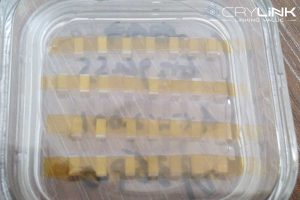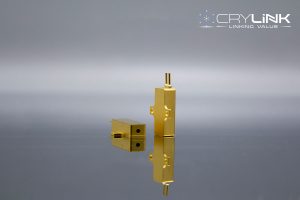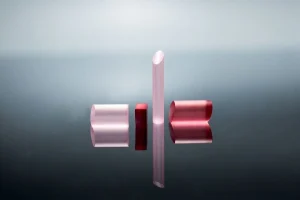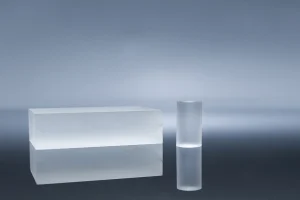Brief overview of Er Glass Lasers
Er Glass Lasers are solid-state laser that utilizes erbium-doped glass as the active medium. The erbium ions in the glass absorb energy from an external pump source and then emit photons at a specific wavelength. Er Glass Lasers have unique properties, such as high output power, high beam quality, wavelength tunability, and low thermal distortion, making them ideal for various medical, industrial, remote sensing, and defence applications.
Er Glass Lasers emit light in the near-infrared region, typically at a wavelength of approximately 1.5 micrometres, which is highly absorbed by water and hydroxyl groups in materials. This wavelength range is advantageous for various applications, including tissue ablation and welding of specific materials.
Er Glass Lasers also offer high output power, ranging from several watts to kilowatts, making them suitable for industrial applications such as cutting, drilling, and welding metals and ceramics. In the medical field, Er Glass Lasers are utilized for skin resurfacing, teeth whitening, cataract surgery, and other procedures.
Another advantage of Er Glass Lasers is their high beam quality, with low divergence and high pointing stability. This makes them ideal for applications that require precise and accurate laser beams.
Er Glass Lasers also can be wavelength-tuned, allowing them to emit at different wavelengths within the near-infrared range. This makes them useful for atmospheric remote sensing for measuring gases and aerosols.
Finally, Er Glass Lasers have low thermal distortion due to the thermal properties of the erbium-doped glass. This makes them ideal for applications that require high precision and accuracy.
Overall, Er Glass Lasers offer unique advantages and have a wide range of applications in various fields, making them valuable tools in research and industry.

Er Glass
Applications of Er Glass Lasers
(1) Medical Applications
Er Glass Lasers have several medical applications due to their unique properties, wavelength, and high output power. Some of the medical applications of Er Glass Lasers include:
Skin Resurfacing:
Er Glass Lasers are used in dermatology for skin resurfacing. The laser energy is absorbed by the water in the skin, causing the skin to vaporize and creating a controlled injury. This injury triggers the body’s natural healing response, resulting in smoother and more youthful-looking skin.
Teeth Whitening:
Er Glass Lasers are used in dentistry for teeth whitening. The pigments in the teeth absorb the laser energy, causing them to break down into smaller particles that can be removed more easily. This results in a brighter and whiter smile.
Cataract Surgery:
Er Glass Lasers are used in ophthalmology for cataract surgery. The laser energy breaks up the eye’s cloudy lens, allowing it to be removed more easily. This results in improved vision for the patient.
Tissue Ablation:
Er Glass Lasers can be used for tissue ablation, which removes tissue using laser energy. This technique can treat various medical conditions, such as tumours and benign lesions.
Laser-Assisted Liposuction:
Er Glass Lasers can be combined with traditional liposuction techniques to enhance fat removal and skin tightening. The laser energy can break down fat cells, making them easier to remove and stimulating collagen production for skin tightening.
Er Glass Lasers offer various medical applications due to their unique properties and precise control. As research and development continue, Er Glass Lasers’ medical applications’ potential will expand.
(2) Material Processing
Er Glass Lasers have a wide range of applications in material processing due to their high output power and beam quality. Material processing refers to the various techniques used to alter the properties of materials, such as cutting, drilling, and welding.
Er, glass lasers typically cut different materials, such as metals, ceramics, and plastics, by focusing laser energy on a small area to melt and vaporize the material. This process produces clean and precise cuts without thermal damage to the surrounding material.
Welding:
Er Glass Lasers can be used for welding various materials, including metals and plastics. The laser energy is focused on the joint between two materials, causing the materials to melt and bond. This process can produce high-quality welds with minimal distortion.
Marking and Engraving:
Er Glass Lasers can be used for marking and engraving various materials, including metals, plastics, and ceramics. The laser energy can create high-contrast marks and designs with high precision and accuracy.
Er Glass Lasers offer several advantages over other types of lasers in material processing, including their high output power and beam quality. Er Glass Lasers can also operate at high repetition rates, making them suitable for high-speed manufacturing applications.
In addition, Er Glass Lasers can be operated in a pulsed or continuous wave mode, allowing for greater control over the laser energy and its effect on the material being processed. This flexibility in operation allows for a wide range of applications in material processing.
Overall, Er Glass Lasers offer a valuable tool in material processing due to their unique properties and precise control. Er Glass Lasers’ material processing potential will expand as research and development continue.
(3) Remote Sensing
Er Glass Lasers have several applications in remote sensing due to their unique properties, including their wavelength and high output power. Remote sensing refers to data collection from a distance, typically using sensors or imaging devices.
Atmospheric Remote Sensing:
Er Glass Lasers are used in atmospheric remote sensing for measuring gases and aerosols. The laser energy is emitted into the atmosphere, and the scattered light is measured to determine the composition and properties of the atmosphere.
LIDAR:
Er Glass Lasers are used in LIDAR (Light Detection and Ranging) for remote sensing applications, such as mapping, topography, and vegetation analysis. The laser energy is emitted from an aircraft or satellite, and the scattered light is measured to create a 3D map of the studied area.
Environmental Monitoring:
Er Glass Lasers are used for environmental monitoring, such as measuring water quality and air pollution. The laser energy is emitted into the water or air, and the scattered light is measured to determine the presence and concentration of various substances.
Remote Sensing of Objects:
Er Glass Lasers can remotely sense objects like satellites and space debris. The laser energy is emitted from the ground or another satellite, and the scattered light is measured to determine the position and velocity of the object being studied.
Er Glass Lasers offer several advantages over other types of lasers in remote sensing, including their high output power and wavelength tunability. Er Glass Lasers can also operate at high repetition rates, making them suitable for rapid data collection.
In addition, Er Glass Lasers have a narrow spectral linewidth, allowing for greater precision in remote sensing measurements. This precision is particularly important in atmospheric remote sensing, where small changes in the atmosphere’s composition and properties can significantly impact weather and climate.
Overall, Er Glass Lasers offer a valuable tool in remote sensing due to their unique properties and precise control. As research and development continue, the potential for Er Glass Lasers in remote sensing applications will expand further.
(4) Defense and Security
Er Glass Lasers have several applications in defense and security due to their unique properties, including their high output power and beam quality. Some of the defense and security applications of Er Glass Lasers include:
Target Designation:
Er Glass Lasers can be used for target designation, identifying and designing a target for attack. The laser energy can mark a target for a guided missile or another precision-guided weapon.
Illumination:
Er Glass Lasers can be used for illumination, providing a high-intensity light source for night vision and other imaging systems.
Ranging:
Er Glass Lasers can be used for ranging, determining the distance to a target. The laser energy can measure the time it takes for the light to travel to the target and back, allowing for accurate distance measurements.
Countermeasures:
Er Glass Lasers can be used for countermeasures, such as blinding enemy sensors and disrupting communication systems.
Directed Energy Weapons:
Er Glass Lasers can be used in directed energy weapons, which use laser energy to destroy or disable targets. These weapons can be more precise and less destructive than traditional weapons.
Er Glass Lasers offer several advantages over other types of lasers in defense and security applications, including their high output power and beam quality. Er Glass Lasers can also operate at high repetition rates, making them suitable for rapid target designation and engagement.
In addition, Er Glass Lasers have a narrow spectral linewidth, allowing for greater precision in ranging and targeting applications. This precision is particularly important in defense and security applications, where accuracy and reliability are critical.
Overall, Er Glass Lasers offer a valuable tool in defense and security due to their unique properties and precise control. As research and development continue, the potential for Er Glass Lasers in defense and security applications will expand further.
Advantages of Er Glass Lasers
Er Glass Lasers offer several advantages over other lasers, making them a valuable tool in various fields. Some of the advantages of Er Glass Lasers include the following:
High Output Power:
Er Glass Lasers can produce high output powers in several watts to kilowatts. This makes them well-suited for industrial and defense applications that require high power levels.
High Beam Quality:
Er Glass Lasers produce high-quality beams with low divergence and high pointing stability. This makes them ideal for applications that require precise and accurate laser beams, such as material processing and remote sensing.
Wavelength Tunability:
Er Glass Lasers can be tuned to emit at different wavelengths within the near-infrared region. This makes them useful for various applications, including medical, industrial, and environmental sensing.
Low Thermal Distortion:
Er Glass Lasers have low thermal distortion due to the thermal properties of the erbium-doped glass. This makes them ideal for applications that require high precision and accuracy, such as material processing.
Cost-Effective:
Er Glass Lasers are relatively cost-effective compared to other lasers, making them accessible to many users.
Overall, Er Glass Lasers offer unique advantages that make them a valuable tool in various fields, including medicine, industry, remote sensing, and defense. Er Glass Lasers’ potential in these applications will expand as research and development continue.

Er Glass Laser
Conclusion
Er Glass Lasers have already found numerous applications in various fields, but the potential for future developments in this technology is significant. Some potential future developments of Er Glass Lasers include:
Higher Output Powers:
Research into new doping techniques and laser cavity designs could lead to higher output powers from Er Glass Lasers, making them even more useful for industrial and defense applications.
New Wavelengths:
Further research into an erbium-doped glass and laser cavity design could lead to new wavelengths for Er Glass Lasers, further expanding their applications.
Improved Efficiency:
Improvements in the efficiency of Er Glass Lasers could make them more cost-effective and reduce their environmental impact.
Miniaturization:
Advances in micro- and nanofabrication techniques could enable the development of miniaturized Er Glass Lasers, which could be used in portable and handheld devices.
New Applications:
Ongoing research into Er Glass Lasers could uncover new applications for this technology, such as in quantum technology and biomedicine.
Overall, Er Glass Lasers have already made significant contributions in various fields, and ongoing research and development will likely lead to even more applications and advancements in the future. The potential for Er Glass Lasers to continue to advance and find new applications is significant, making this technology a promising area of research and development.






